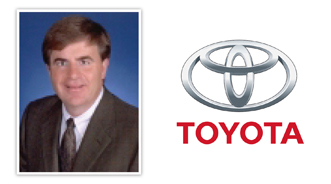Discussion about Dealership Upgrades Revisited during Recent J.P. Morgan Event

An investment analyst recently asked Toyota’s Bob Carter about a subject studied intently by the National Automobile Dealers Association — automakers asking franchised dealers to make mandated changes to their showrooms and more.
The questioner wanted to know if $1 billion worth of improvements were going to bring a strong return on investment for both the OEM and dealerships. Carter responded by beginning with how the topic was an area of personal pride for him.
“We have a philosophical difference between our relationship with dealers that I hear all the time and I sure that you may, but we truly operate this company as a partnership with our dealers,” the group vice president and general manager of the Toyota division continued during the recent J.P. Morgan Automotive Conference.
“What drives us is the more successful our dealers are, the more successful we are,” Carter insisted. “We do not and will not tolerate an adversarial relationship with our dealers. It’s something that I believe very strongly in, and it’s felt by others in the company.”
Responding to dealer concerns, NADA first commissioned the study “Factory Image Programs” last August. NADA stressed that the study looked at various factors, both good and bad, regarding the return on investment in dealership facility upgrade programs.
“The goal of the study is to move the facilities’ investment decision onto a more rational, informed and fact-driven footing,” former NADA chairman Stephen Wade said during the NADA Convention and Expo in Las Vegas this past February.
The study dealt with three types of store upgrades, as listed below:
—Expansion: “adding a showroom or service bays to support growth in UIO, for example.”
—Modernization: “upgrading facilities to contemporary standards in tile, furniture and fixtures, etc.”
—Standardization: “designing the interior and exterior look to ensure that every store selling a given brand looks as much like the other stores as possible.”
And when looking at dealership expansion, study results reveal cause for concern.
“In terms of dealership expansion, the study found that unreasonably high and frequently changing OEM volume forecasts, as well as outdated capacity formulas can lead to overbuilding and waste,” Wade said.
“So better, more reasonable forecasting should make expansion investments easier for dealers to support,” he went on to stress.
Meanwhile, during last week’s J.P. Morgan event in New York, Carter emphasized the strong relationship between Toyota and its franchised dealers and how together they navigated through the recall challenges of 2010 and the ramifications of the Japanese earthquake and tsunami a year ago.
“We had a tough two years,” Carter acknowledged. “We worked hand-in-hand with our dealers, and our dealers continued to receive a very good if not industry leading return on their investment. Because of that, our partnership with our dealers became even stronger today than it was prior to those events.”
Later this month, Carter mentioned he and other executives will gather with Toyota dealers in Las Vegas to show them six new models that stores will begin to sell during the next 18 months.
“They have a tremendous amount of confidence seeing and hearing about this new product we’re bringing to market,” he noted.
In closing his response to the questioner, Carter referred back to the $1 billion figure the event participant mentioned.
“The investment you’re seeing, that’s dealer money; there is no incentives,” Carter emphasized. “We don’t pay dealers to do image programs. We do not give dealers what I call two-tier pricing; you build a facility, and we’ll give you another point of margin. Many manufacturers are doing that. I think, fundamentally, it’s not the right business models.
“Our dealers are doing it because they believe the investment in Toyota gains them the highest return on investment. That’s just natural dollars coming into the system,” he continued.
“Sure, we encourage dealers to meet our image plans. But it’s an encouragement and a partnership, not a financial inducement and not an arm-twisting situation that is well publicized in the industry,” Carter went on to say.
How to Reach Younger Buyers
Earlier during the question-and-answer session after Carter gave conference attendees an overview of Toyota’s current standing — comments that can be found here — another participant asked him about how the OEM is reaching younger buyers in light of analysis saying that this demographic is putting off vehicle purchases.
“I think it would be a mistake to say it’s a structural society change. I also think it would be a mistake to disregard what’s happening in the market as cyclical. Certainly the challenges in the economy have been difficult for that younger buyer,” Carter indicated.
“We are seeing younger buyers enter the car market at a later stage of their life than previous generations,” he continued. “We’re seeing them in their late 20s, early 30s, particularly when young families come into the brands. That’s an important trend that we’re identifying because we’re using that information to develop future products for us.
“Younger consumers are responding to more emotional design,” Carter surmised. “But emotional design or emotional products are not the same as previous generation where it’s strictly on fun-to-drive characteristics and performance. They’re responding to utility and responding to higher technology.
“If you offer a product that appeals to that consumer, you can change the demographics. Younger buyers are the future of our product, and I think everyone in the industry is working toward them,” he concluded.

 View The Latest Edition
View The Latest Edition

